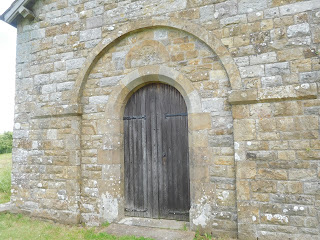Monday, July 25, 2022
Aran Jumpers
Monday, July 04, 2022
St Bees Head
Although I was born and raised not ten miles from St Bees, I have never been to the cliff-top walk before. I have eaten ice-creams on the beach there and looked up at the cliffs but never actually seen the view from the top.
It was a brilliantly sunny day with the sea a shimmering blue on the day that we made the trip this time. To get there you drive to the red sandstone village of Sandwith - pronounced Sannith - and turn up a private road to a farm and, further than that, a light-house. Parking at the farm was clear enough but not the onward path which turned out to be through a gated off section of road full of cows with suckler calves - something one would wish to avoid.
Once through we headed for light-house and the coastal path.
In the distance, the Isle of Man was dimly outlined. Near at hand the sea was boiling with auks - guillemots and razorbills.
The RSPB has made three secure viewpoint enclosures from which to get an angle on the vertical stacks where the birds nest. In one of these two doughty Scots had set up camp with a telescope and long-lensed camera trained on the grassy mound topping the cliff. If those were puffin burrows and if puffins were in residence they were in position to record the evidence. We never saw them.
What we did see was guillemots crowded on the narrow ledges.
And gulls feeding large chicks on the grassy tops.
We saw fulmars in flight and even a gannet cruising past.
We certainly smelt the guano from all the seabirds.
And then we drove down to the beach and enjoyed an ice-cream.
Saturday, July 02, 2022
Old Parish Churches.
Not everyone's cup of tea, perhaps, but faced with a wet and windy walk we decided to do some exploring using Mike Salter's book "Old Parish Churches of Cumbria".
Click on any of the pictures to enlarge them.
First we drove to Torpenhow, a village near Wigton. The parish church, built 1120, was large with massive pillars and really impressive Norman arches - but very dark. The deep window embrasures show how thick the walls are - this building made use of stone from Old Carlisle, a Roman settlement.
At the top of the pillars, grotesque, Romanesque carvings showing the damned writhing in torment on one side and, on the other, the virtuous rejoicing at being spared. Dark interiors do not make good photos but this was an atmospheric space, surprising for a small country parish.
Next, a complete contrast in the abandoned old church at Ireby. It is literally across a field and buried in unmown grass, but not a ruin and still maintained.
Only the chancel still exists. Two columns which once supported the nave were recovered from the village where they were being used as gateposts.
Inside, this carved stone dated 1606, commemorating a gentleman who served Elizabeth, James and Charles.
The interior here appears more traditional than Torpenhow - until you look up. Then you see the very impressive high barrel-vaulted roof, following, apparently, a style used in Provence.
A traditional stained glass window.
And a modern one made by a local maker who also made the one in Caldbeck church. Notice the Good Shepherd dressed as a Cumbrian, and the very apt wording.
All of these churches were originally dual-purpose, needing to be defensive structures against raiding parties from the North.
We can see much more church tourism in our future.
Friday, July 01, 2022
Brackenthwaite How
A recently developed walk takes you to the top of Brackenthwaite How, a viewpoint favoured by the Victorians. It certainly gives wonderful panoramic views without very much effort in the ascent.
We relocated a mile or so down the lake to Cinderdale Common, and took a short walk to the foot of Rannerdale for our lunch stop.
It must be spectacular after heavy rain.
.JPG)
.JPG)
.JPG)
.JPG)






.JPG)

.JPG)






.JPG)






.JPG)




.JPG)
.JPG)